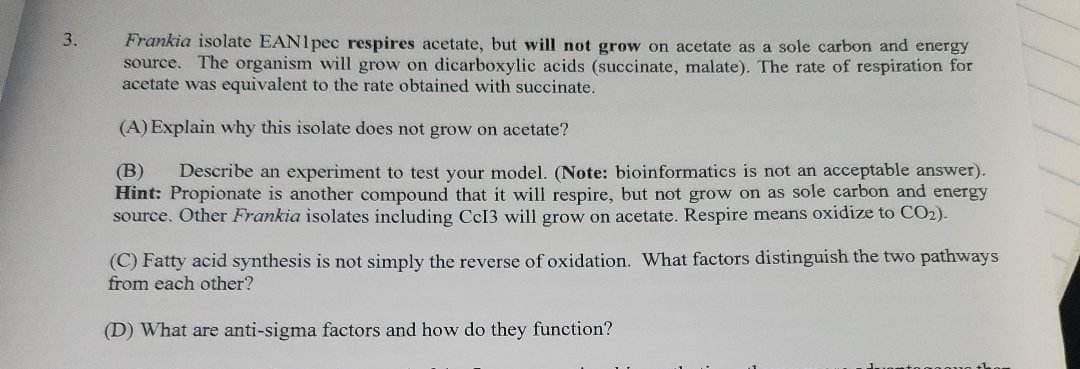Frankia isolate EAN1pec respires acetate, but will not grow on acetate as a sole carbon and energy source. The organism will grow on dicarboxylic acids (succinate, malate). The rate of respiration for acetate was equivalent to the rate obtained with succinate. (A) Explain why this isolate does not grow on acetate? (B) Describe an experiment to test your model. (Note: bioinformatics is not an acceptable answer). Hint: Propionate is another compound that it will respire, but not grow on as sole carbon and energy source. Other Frankia isolates including CcI3 will grow on acetate. Respire means oxidize to CO2). (C) Fatty acid synthesis is not simply the reverse of oxidation. What factors distinguish the two pathways from each other? (D) What are anti-sigma factors and how do they function?
Frankia isolate EAN1pec respires acetate, but will not grow on acetate as a sole carbon and energy source. The organism will grow on dicarboxylic acids (succinate, malate). The rate of respiration for acetate was equivalent to the rate obtained with succinate. (A) Explain why this isolate does not grow on acetate? (B) Describe an experiment to test your model. (Note: bioinformatics is not an acceptable answer). Hint: Propionate is another compound that it will respire, but not grow on as sole carbon and energy source. Other Frankia isolates including CcI3 will grow on acetate. Respire means oxidize to CO2). (C) Fatty acid synthesis is not simply the reverse of oxidation. What factors distinguish the two pathways from each other? (D) What are anti-sigma factors and how do they function?
Human Anatomy & Physiology (11th Edition)
11th Edition
ISBN:9780134580999
Author:Elaine N. Marieb, Katja N. Hoehn
Publisher:Elaine N. Marieb, Katja N. Hoehn
Chapter1: The Human Body: An Orientation
Section: Chapter Questions
Problem 1RQ: The correct sequence of levels forming the structural hierarchy is A. (a) organ, organ system,...
Related questions
Question

Transcribed Image Text:3.
Frankia isolate EAN1pec respires acetate, but will not grow on acetate as a sole carbon and energy
source. The organism will grow on dicarboxylic acids (succinate, malate). The rate of respiration for
acetate was equivalent to the rate obtained with succinate.
(A) Explain why this isolate does not grow on acetate?
(B) Describe an experiment to test your model. (Note: bioinformatics is not an acceptable answer).
Hint: Propionate is another compound that it will respire, but not grow on as sole carbon and energy
source. Other Frankia isolates including CcI3 will grow on acetate. Respire means oxidize to CO₂).
(C) Fatty acid synthesis is not simply the reverse of oxidation. What factors distinguish the two pathways
from each other?
(D) What are anti-sigma factors and how do they function?
Expert Solution
This question has been solved!
Explore an expertly crafted, step-by-step solution for a thorough understanding of key concepts.
Step by step
Solved in 4 steps

Knowledge Booster
Learn more about
Need a deep-dive on the concept behind this application? Look no further. Learn more about this topic, biology and related others by exploring similar questions and additional content below.Recommended textbooks for you

Human Anatomy & Physiology (11th Edition)
Biology
ISBN:
9780134580999
Author:
Elaine N. Marieb, Katja N. Hoehn
Publisher:
PEARSON

Biology 2e
Biology
ISBN:
9781947172517
Author:
Matthew Douglas, Jung Choi, Mary Ann Clark
Publisher:
OpenStax

Anatomy & Physiology
Biology
ISBN:
9781259398629
Author:
McKinley, Michael P., O'loughlin, Valerie Dean, Bidle, Theresa Stouter
Publisher:
Mcgraw Hill Education,

Human Anatomy & Physiology (11th Edition)
Biology
ISBN:
9780134580999
Author:
Elaine N. Marieb, Katja N. Hoehn
Publisher:
PEARSON

Biology 2e
Biology
ISBN:
9781947172517
Author:
Matthew Douglas, Jung Choi, Mary Ann Clark
Publisher:
OpenStax

Anatomy & Physiology
Biology
ISBN:
9781259398629
Author:
McKinley, Michael P., O'loughlin, Valerie Dean, Bidle, Theresa Stouter
Publisher:
Mcgraw Hill Education,

Molecular Biology of the Cell (Sixth Edition)
Biology
ISBN:
9780815344322
Author:
Bruce Alberts, Alexander D. Johnson, Julian Lewis, David Morgan, Martin Raff, Keith Roberts, Peter Walter
Publisher:
W. W. Norton & Company

Laboratory Manual For Human Anatomy & Physiology
Biology
ISBN:
9781260159363
Author:
Martin, Terry R., Prentice-craver, Cynthia
Publisher:
McGraw-Hill Publishing Co.

Inquiry Into Life (16th Edition)
Biology
ISBN:
9781260231700
Author:
Sylvia S. Mader, Michael Windelspecht
Publisher:
McGraw Hill Education